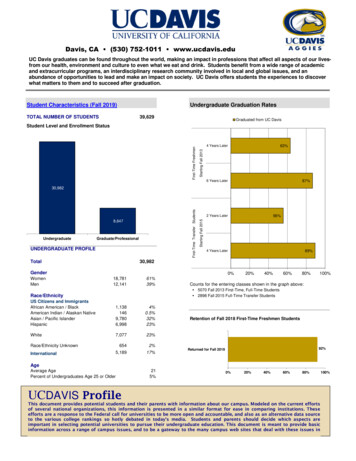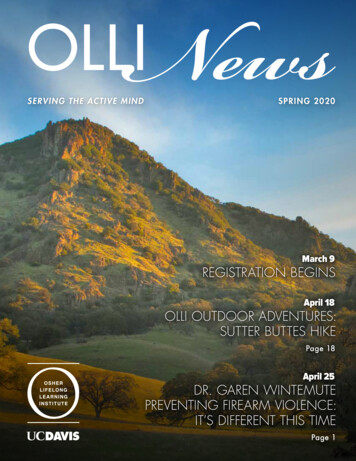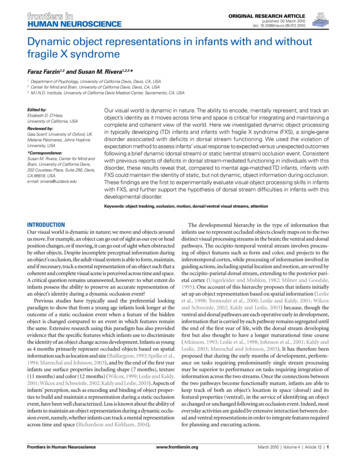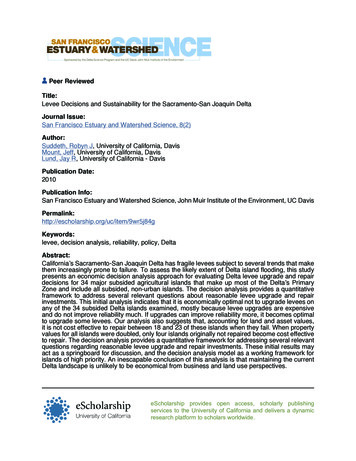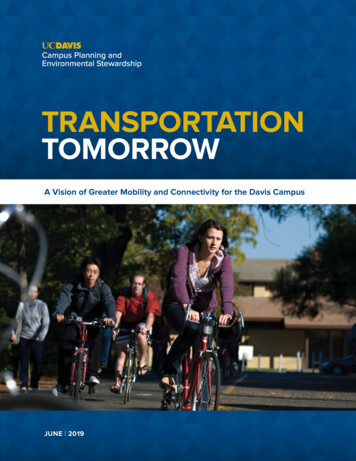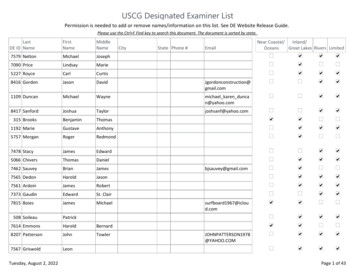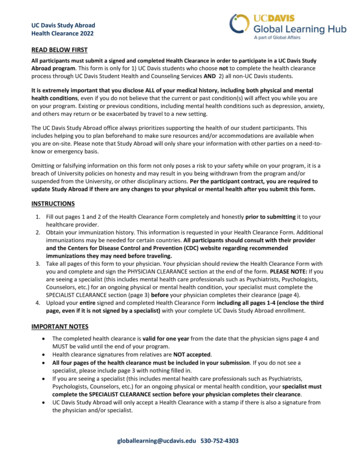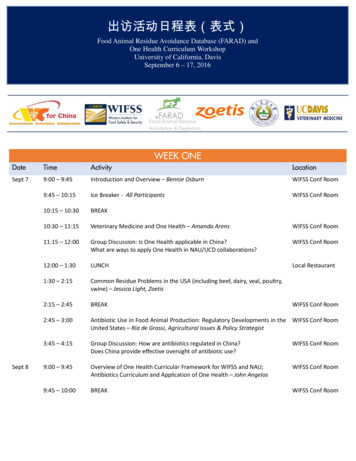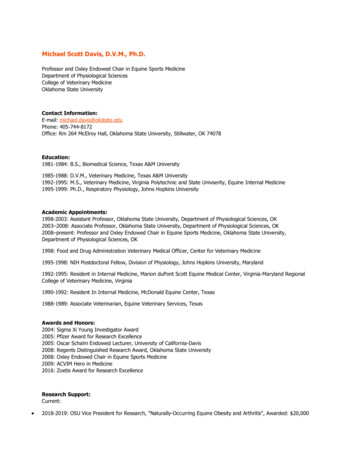
Transcription
Michael Scott Davis, D.V.M., Ph.D.Professor and Oxley Endowed Chair in Equine Sports MedicineDepartment of Physiological SciencesCollege of Veterinary MedicineOklahoma State UniversityContact Information:E-mail: michael.davis@okstate.eduPhone: 405-744-8172Office: Rm 264 McElroy Hall, Oklahoma State University, Stillwater, OK 74078Education:1981-1984: B.S., Biomedical Science, Texas A&M University1985-1988: D.V.M., Veterinary Medicine, Texas A&M University1992-1995: M.S., Veterinary Medicine, Virginia Polytechnic and State Univserity, Equine Internal Medicine1995-1999: Ph.D., Respiratory Physiology, Johns Hopkins UniversityAcademic Appointments:1998-2003: Assistant Professor, Oklahoma State University, Department of Physiological Sciences, OK2003–2008: Associate Professor, Oklahoma State University, Department of Physiological Sciences, OK2008–present: Professor and Oxley Endowed Chair in Equine Sports Medicine, Oklahoma State University,Department of Physiological Sciences, OK1998: Food and Drug Administration Veterinary Medical Officer, Center for Veterinary Medicine1995-1998: NIH Postdoctoral Fellow, Division of Physiology, Johns Hopkins University, Maryland1992-1995: Resident in Internal Medicine, Marion duPont Scott Equine Medical Center, Virginia-Maryland RegionalCollege of Veterinary Medicine, Virginia1990-1992: Resident In Internal Medicine, McDonald Equine Center, Texas1988-1989: Associate Veterinarian, Equine Veterinary Services, TexasAwards and Honors:2004: Sigma Xi Young Investigator Award2005: Pfizer Award for Research Excellence2005: Oscar Schalm Endowed Lecturer, University of California-Davis2008: Regents Distinguished Research Award, Oklahoma State University2008: Oxley Endowed Chair in Equine Sports Medicine2009: ACVIM Hero in Medicine2016: Zoetis Award for Research ExcellenceResearch Support:Current: 2018-2019: OSU Vice President for Research, "Naturally-Occurring Equine Obesity and Arthritis", Awarded: 20,000
2018-2019: OSU Vice President for Research, "Importance of Obesity and Arthritis", Awarded: 20,0002018-2019: OSU Vice President for Research, "Novel Large Animal Model of Cardio-metabolic Disease", Awarded: 24,9692018-2019: OSU-CVHS-RAC, "The Effects of Cellular Acidosis on Equine Skeletal Muscle Oxidative Phosphorylation",Awarded: 14,9312018-2019: OSU-CVHS-RAC, "Mechanism of Conditioning-Induced Increase in Peripheral Glucose Clearance",Awarded: 25,0002018-2019: Oklahoma Center for Respiratory and Infectious Disease (COBRE Pilot Project), "Effect of Airway MucosalCooling and Hypersmolarity on Innate Immune Function", Awarded: 50,0002019-2020: American Kennel Club Canine Health Foundation, "Effect of hyperthermia on skeletal muscle energyefficiency", Awarded: 14,831Past:1993-1995: Clinical Initiatives Grant, Virginia-Maryland Regional College of Veterinary Medicine, "Evaluation of clinicalmethods of pulmonary function assessment in the standing horse", Awarded: 1,8541993-1995: Paul Mellon Equine Research Fund, "Evaluation of clinical measurements of pulmonary gas exchangeefficiency in the horse", Awarded: 11,6611995-1996: Chrysler Corp Triple Crown Awards, "Lower respiratory disease in Thoroughbred racehorses: Quantifyinglung dysfunction and response to treatment", Awarded: 33,0001997: Thoroughbred Retirement Foundation, "Hyperpnea-induced airway injury in horses", Awarded: 5,0001997-1998: NIH-NHLBI Individual NRSA, "Effects of repeated dry air challenge on canine peripheral airways",Awarded: 70,0001999-2002: OCAST Health Research Programs, "Pathogenic Mechanisms in Exercise-Induced Asthma", Awarded: 120,7281998-2002: Thoroughbred Charities of America, "Hyperpnea-induced airway injury in horses", Awarded: 25,0001999: Oklahoma State University College of Veterinary Medicine Seed Grant, "Effect of laser staphlectomy on softpalate function in brachycephalic dogs", Awarded: 12,0001999: Oklahoma Agricultural Experiment Station, "Detection of Bovine Respiratory Disease Complex Susceptibilityusing Markers of Oxidative Stress", Awarded: 22,1602001-2004: Morris Animal Foundation, "Expired Breath Ethane as a Marker of Gastrointestinal Reperfusion Injury",Awarded: 40,0002001-2003: Oklahoma Agricultural Experiment Station, "Scintigraphic Evaluation of Exercise-Induced Airway MucosalInjury", Awarded: 44,0002002-2004: USDA-CREES, "Effects of Unconditioned Air on Equine Peripheral Airways", Awarded: 200,0002002-2005: NIH, "Animal Models of Exercise-Induced Airway Disease", Awarded: 854,7202002-2003: DARPA/DOD, "Effect of Strenuous Exercise on Gastrointestinal Permeability", Awarded: 31,2712003-2006: Oklahoma State University Presidential Challenge Grants, "Effects of subclinical intoxication withanticholinesterases on pulmonary mechanical properties and susceptibility to acute asthma", Awarded: 75,000(PROGRAM CANCELLED DUE TO BUDGET SHORTFALLS)2003-2005: Defense Sciences Office (DARPA), "Pathophysiology and Biomarkers of Sustained Exertion DiseaseSyndromes", Awarded: 1,466,6082003-2004: Oklahoma Agricultural Experiment Station, "Oxidative Stress in Racehorses", Awarded: 15,0002004-2007: National Institutes of Health National Center for Research Resources, "NCRR Training Grant forVeterinary Students in Research", Awarded: 247,3242004-2005: Research Advisory Committee, "Eicosanoids in Cold-Induced Airway Mucosal Injury", Awarded: 18,5002004: Rosetta Inpharmatics LLC, Awarded: Confidential.2005: International Federation of Sleddog Sports, "Membrane Damage Due To Oxidative Stress From ProlongedExercise As A Potential Mechanism Promoting Gastric Erosions: A Pilot Study To Define “Burned MembraneSyndrome”, Awarded: 5,0002005-2006: Research Advisory Committee, Oklahoma State University College of Veterinary Medicine, "Metabolicstrategy for fatigue resistance during extended exercise", Awarded: 18,0002005-2007: Oklahoma Agricultural Experiment Station, "Cold Air-Induced Airway Inflammation andImmunosuppression in Horses", Awarded: 47,8002006-2007: ACVIM Foundation, "Efficacy of famotidine for the prevention of stress-induced gastric ulcers", Awarded: 8,795
2006-2008: ACVIM Foundation, "Mechanism of exercise-induced airway immunosuppression in horses", Awarded: 19,9602006-2009: Oklahoma Agricultural Experiment Station, "Centennial Scholars Predoctoral Training Grant" , Awarded: 60,0002006: Oklahoma EPSCoR, "Oklahoma NASA-EPSCoR Travel Grant", Awarded: 8002007: Defense University Research Instrumentation Program, "Field Laboratory for the Study of Fatigue-Resistance",Awarded: 150,0002007-2008: DARPA-DSO (Subcontract through SRI International), "Predicting Health and Disease", Awarded: 144,227 (Parent contract revoked prior to completion of project)2007-2008: Technology Business Assessment Group, Oklahoma State University, "Gastroprotective Effect of a NovelSalt Supplement for Horses", Awarded: 32,4002007: Coldwater Cattle Company Texas, "Non-Invasive Measurement of Fluid Compartments using BioelectricalImpedance Analyzer", Awarded: 20,1512007-2009: DARPA-DSO (Subcontract through Texas A&M University), "Evaluation of Fatigue Resistance in AlaskanSled Dogs as a Model to Improve Peak Soldier Performance", Awarded: 62,9342008: American Kennel Club, "Predictive Serum Biomarkers for Canine Endurance Exercise", Awarded: 12,6492008-2009: OSU-CVHS-RAC, "Strategic administration of therapeutic aerosols for the preventionof exercise-induced airway inflammation in horses", Awarded: 11,3432008-2009: OSU-CVHS-RAC, "Mechanism of cold air-induced respiratory immunosuppression", Awarded: 14,1402008: OSU Office of the Provost, Big 12 Fellowship Visit to Iowa State University (Mark Ackermann), Awarded: 2,0002008-2009: Oklahoma Agricultural Experiment Station, "Adaptation of young horses to fat utilization during exercise",Awarded: 24,9802008-2010: Morris Animal Foundation, "Exercise stress-induced gastrointestinal disease in dogs", Awarded: 19,1752009: Diabetes Action Research and Education Foundation & Research Advisory Committee, Center for VeterinaryHealth Sciences, Oklahoma State University, "Effect of conditioning on acute metabolic responses to exercise incanine muscle", Awarded: 30,0002009-2010: American Kennel Club, "Capacity for respiratory-based thermoregulation in brachycephalic breeds",Awarded: 12,4742009-2010: American Kennel Club, "Measuring ventilatory responses to heat stress in dogs", Awarded: 47,0062009-2013: Army Research Office Division of Life Sciences, Department of Defense, "Muscle adaptations permittingfatigue-resistant exercise", Awarded: 1,027,6122010-2011: Army Research Office Division of Life Sciences, Department of Defense, High School ApprenticeshipProgram, Awarded: 6,0002010-2013: DARPA-DSO (Subcontract through University of Colorado), "Combinatorial drug screening to identifystrategies to enhance ground troop readiness at high altitude", Awarded: 1,335,6512011: Defense University Research Instrumentation Program, "Field Laboratory for the Study of Fatigue-Resistance",Awarded: 114,624 Army Research Office STTR (Corporate Partner Strategic Feasibilities, Inc), Expedited Training Device for Rats,Awarded: 30,6962011-2013: Office of Naval Research (Subcontract through K2 Solutions, Inc), "Developing IDD 2.0", Awarded: 927,2462011: Morris Animal Foundation, "Morris Animal Foundation Summer Student Fellowship", Awarded: 5,500Ablynx, Inc, Efficacy study and safety assessment following multiple dosing of inhaled ALX-0171 in RSV-infectedneonatal lambs (Ackerman M, PI), Awarded: 16,9132012-2017: Office of Naval Research, "Building a Better Canine Warrior", Awarded: 2,308,2822013-2017: Army Research Office Division of Life Sciences, Department of Defense, "Metabolic strategy for fatigueresistance", Awarded: 588,4342013: Companion Animal Instrumentation Grant, Oklahoma State University Center for Veterinary Health Science,"High-Resolution Respirometry", Awarded: 50,4812015-2016: OSU-CVHS-RAC, "Physiological Remodeling and Stress Resistance in Dogs", Awarded: 42,5002016-2017: US Special Operations Command, "Tolerance of Dogs to Acute Hypobaric Hypoxia", Awarded: 668,6612017-2018: Oklahoma Agricultural Experiment Station, "The Role of Hyperthermia in Exertional Rhabdomyolysis",Awarded: 13,880
Selected Publications:1. Murray MJ, del Piero F, Jeffrey SC, Davis MS, Furr MO, Dubovi EJ, and Mayo JA. Neonatal Equine Herpesvirus Type 1Infection on a Thoroughbred Breeding Farm. Journal of Veterinary Internal Medicine 12:36-41, 1998.2. Davis MS*, Murray MJ, and Donaldson LL. Clinical Assessment of Gas Exchange in Mature Horses. Equine Vet.J.30(4):396-400, 1998.3. Davis MS*, Murray MJ, and Carman RJ. Diagnosis and Treatment of Clostridial Colitis in a Mare. Veterinary Medicine1999 April; 363-366.4. Freed AN and Davis MS. Effects of hyperventilation on peripheral airway surface fluid and airway resistance.Am.J.Respir.Crit.Care Med 1999; 159(4):1101-1107.5. Davis MS and Freed AN. Repetitive hyperventilation causes peripheral airway obstruction and eosinophilia. EurRespir J 1999 Jul;14(1):57-62.6. Davis MS* and Foster WM. Airflow and device effects on aerosol delivery for large animals. J.Vet.Pharm.Ther. 24(1),57-60, 2001.7. Davidson EB, Davis MS, Campbell GC, Healey T, Williamson KK, Payton M, Bartels KE. Soft palate resection usingCO2 laser and suture technique in brachycephalic dogs. JAVMA 219(6): 776-781, 2001.8. Davis MS and Freed AN. Repeated Hyperventilation causes Peripheral Airways Inflammation, Hyperreactivity andImpaired Bronchodilation in Dogs. Am.J.Respir.Crit.Care Med 2001; 164(5):785-789.9. Davis MS, McCulloch S, Myers T, and Freed AN. Eicosanoids Modulate Hyperventilation-Induced Late Phase AirwayObstruction and Hyperreactivity, but not Inflammation, in Dogs. Respir Physiol 2002 Jan;129(3):357-6510. Davis MS*, Royer CM, Payton ME, Buttress B. Modeling the Late Phase Dose-Response Relationship to PeripheralAirway Hyperpnea. J Appl Physiol. 2002 Jul;93(1):195-200.11. Duggan VE, MacAllister CG, Davis MS. Xylazine attenuation of epiglottic dysfunction in a yearling Quarter Horsefilly. J Am Vet Med Assoc. 2002 Aug 1;221(3):399-401, 368.12. Davis MS*, Lockard AJ, Marlin DJ, and Freed AN. Airway cooling and mucosal injury during cold weatherexercise. Equine Vet J. Suppl 34:413-416, 2002.13. Davis MS*, McKiernan B, McCullough S, Nelson, SL, Mandsager RE, Willard M, and Dorsey K. Racing Alaskan SledDogs as a Model of “Ski Asthma”. Am J Respir Crit Care Med. 2002 Sep 15;166(6):878-82.14. Davis MS*, Willard MD, Nelson SL, McCullough SM, Mandsager RE, Roberts JE, Payton ME. Efficacy of omeprazole15.16.17.18.19.20.21.22.23.24.for the prevention of exercise-induced gastritis in racing Alaskan sled dogs. J Vet Intern Med. 2003 MarApr;17(2):163-6.Davis MS*, Schofield B, and Freed AN. Repeated Hyperventilation causes Peripheral Airways Inflammation andRemodeling in Dogs. Med Sci Sports Exerc. 2003 Apr;35(4):608-616.Davis MS*, Daviskas E, Anderson SD, Kotaru C, Hejal RB, Finigan JH, Coreno AJ, Skowronski ME, Brianas L,McFadden ER Jr. Airway surface fluid desiccation during isocapnic hyperpnea. J Appl Physiol. 2003 Jun;94(6):25457.Davis MS*, Willard MD, Nelson SL, Mandsager RE, McKiernan BS, Mansell JK, Lehenbauer TW. Prevalence of GastricLesions in Racing Alaskan Sled Dogs. J Vet Intern Med. 2003 May-Jun;17(3):311-4.Davis MS*, Willard MD, Williamson KK, Steiner JM, Williams DA. Sustained Strenuous Exercise Increases IntestinalPermeability in Racing Alaskan Sled Dogs. J Vet Intern Med. 2005 Jan-Feb;19(1):34-39.Davis MS*, Williamson KK, McKenzie EC, Royer CM, Payton ME, Nelson SL. Effect of Training and Rest onRespiratory Mechanical Properties in Racing Sled Dogs. Med Sci Sports Exerc. 2005 Feb;37(2):337-341.Royer CM, Willard MD, Williamson KK, Steiner JM, Williams DA, Davis MS*. Exercise stress, intestinal permeability,and gastric ulceration in racing Alaskan sled dogs. Eq Comp Exerc Physio. 2005 Feb;2(1):53-59.Davis MS*, Malayer JR, VanDeventer L, Royer CM, McKenzie EC, Williamson KK. Cold Weather Exercise and AirwayCytokine Expression. J Appl Physiol. 2005 Jun;98(6):2132-6.Davis MS*, McKenzie EC, Royer CM, Williamson KK, Payton ME, Nelson SL. Effect of Training and Recovery onAirway Inflammation in an Animal Model of “Ski Asthma”. Eq Comp Exerc Physio. 2005 May;2(2):133-138.McKenzie EC, Holbrook TC, Williamson KK, Valberg S, Hinchcliff K, Jose-Cunilleras E, Nelson S, Willard M, DavisMS*. Recovery of muscle glycogen concentrations in sled dogs during prolonged exercise. Med Sci SportsExerc. 2005 Aug;37(8):1307-1312.Durocher L, Hinchcliff KW, Williamson KK, McKenzie EC, Holbrook TC, Willard MD, Royer CM, and Davis MS. Lack ofmicroalbuminuria in sled dogs following exercise. Eq Comp Exerc Physio. 2006; 3(1): 1-2.
25. Bentz BG, Maxwell LK, Erkert RS, Royer CM, Davis MS, MacAllister CM, Clarke CR. Pharmacokinetics of acyclovir 41.42.43.44.45.46.47.48.single intravenous and oral administration to adult horses. Journal of Veterinary Internal Medicine 2006; 20(4):589594.Davis MS*, Willard MD, Williamson KK, Royer CM, Payton M, Steiner JM, Hinchcliff, KW, McKenzie EC, NelsonSL. The Temporal Relationship between Gastrointestinal Protein Loss, Gastric Ulceration or Erosion, and StrenuousExercise in Racing Alaskan Sled Dogs. J Vet Intern Med. 2006; 20(4): 835-839.Davis MS*, Royer CM, McKenzie EC, Williamson KK, Payton ME, Marlin DM. Cold Air-Induced Late-PhaseBronchoconstriction in Horses. Equine Veterinary Journal 2006; 36:535-539.Durocher L, Hinchcliff KW, Williamson KK, McKenzie EC, Holbrook TC, Willard MD, Royer CM, and Davis MS.Strenuous exercise in Alaskan Sled Dogs increases urinary concentrations of homovanillic acid and cortisol but notvanillylmandelic acid. AJVR 2007 Jan;68(1):107-11.Davis, MS*, Williams CC, Meinkoth J, Malayer JR, Royer CM, Williamson KK, and McKenzie EC. Airway NeutrophilInflux and Persistence of Airway TH2 Cytokine Expression after Exercise while Breathing Cold Air. AJVR 2007Feb;68(2):185-9.McKenzie EC, Jose-Cunilleras E, Hinchcliff KW, Holbrook TC, Royer CM, Payton ME, Williamson KK, Nelson SL, WillardMD, Davis MS*. Serum chemistry alterations in Alaskan Sled Dogs during five successive days of prolongedendurance exercise. JAVMA. 2007 May 15;230(10):1486-92.Carlos L, Davis MS. Evidence-based Clinical Question: Does clenbuterol positively affect racing horses? Equine Vet.Educ. 2007; 19(5):229-230.Davis MS*, Williamson KK. Evidence-based Respiratory Medicine. Vet Clin North Am Equine Pract. 2007Aug;23(2):215-27.Pitts SC, Davis MS. Evidence-based Clinical Question: An evidence-based analysis of anabolic steroids as performanceenhancers in horses. Equine Vet. Educ. 2007; 20(1):229-230.Williamson KK, Willard MD, McKenzie EC, Royer CM, Payton ME, Davis MS*. Efficacy of Famotidine for thePrevention of Exercise-Induced Gastritis in Racing Alaskan Sled Dogs. J Vet Intern Med. 2007 Sep-Oct;21(5):924-7.McKenzie EC, Hinchcliff KW, Valberg S, Williamson KK, Payton ME, Davis MS*. Assessment of alterations intriglyceride and glycogen concentrations in muscle tissue of Alaskan sled dogs during repetitive prolonged exercise.Am J Vet Res. 2008 Aug;69(8):1097-103.Davis MS*, Davis WC, Ensign W, Hinchcliff KW, Holbrook TC, and Williamson KK. Effects of training and strenuousexercise on hematologic values and peripheral blood leukocyte subsets in racing sled dogs. J Am Vet Med Assoc.2008 Mar 15;232(6):873-8.Teuschler-Stewart SM, Cooper SR, Davis MS, and Freeman DW. Effect of dietary fat on training-induced myocyteadaptations. Journal of Equine Veterinary Science 29(5): 352-353, 2009.Jann HW, Hart JCA, Moorman VJ, Davis MS. Endoscopic appearance of the glossoepiglottic fold of normalhorses. Comparative Exercise Physiology 2009; 6(3); 109–112.McKenzie EC, Lupfer C, Banse HE, Hinchcliff KW, Love S, Nelson SL, Davis MS, Payton ME, Pastey M. Serum globulinand immunoglobulin concentrations in Alaskan sled dogs participating in a long-distance race. J Vet Intern Med. 2010Jan-Feb;24(1):179-184.Williamson KK, Willard MD, Payton ME, Davis MS*. Efficacy of omeprazole versus high dose famotidine forprevention of exercise-induced gastritis in racing Alaskan sled dogs. J Vet Intern Med. 2010 Mar-Apr;24(2):285-288.Latman N, Keith N, Nicholson A, Davis M. Bioelectrical impedance analysis determination of water content anddistribution in the horse. Res Vet Sci. 2010 Aug 7.Love SB, Davis MS, Goad C, Murphy K, Aichele DB, Fossum TW. Predictive Hematological and Serum Biomarkers forCanine Endurance Exercise. Comparative Exercise Physiology 2011 7(3): 109-115.Ritchey JW, Davis MS, Breshears MA, Willard MD, Williamson KK, Royer CM, Payton ME, CragunAS. Gastritis in Alaskan Racing Sled Dogs. Journal of Comparative Pathology 2011 145: 68-76.Davis MS*, Willard MD, Bowers D, Payton Me. Effect of simulated deployment patrols on gastric mucosa of explosivedetection dogs. Comp Ex Phys 2014 10(2): 99-103.Davis MS*, Bonen A, Snook LA, Jain SS, Bartels K, Geor R, Hueffer K. Conditioning increases the gain of contractioninduced sarcolemmal substrate transport in ultra-endurance racing sled dogs. PLoS One. 2014 Jul 30;9(7).Miller BF, Drake JC, Peelor FF 3rd, Biela LM, Geor RJ, Hinchcliff KW, Davis M, Hamilton KL. Participation in a 1000mile race increases the oxidation of carbohydrate in Alaskan sled dogs. J Appl Physiol (1985). 2014 Aug 21.Pratt-Phillips SE, Geor RJ, Buser M, Zirkle A, Moore A, Love SB, Entin P, Davis MS. Effect of a single bout of exerciseand chronic exercise training on insulin sensitivity in racing sled dogs. Comp Ex Phys, 2014; 10(3):167-172.Drum MG, Marcellin-Little DJ, Davis MS. Principles and Applications of Therapeutic Exercises for Small Animals. VetClin North Am Small Anim Pract. 2015 Jan;45(1):73-90.
49. Miller BF, Ehrlicher S, Drake JC, Peelor FF 3rd, Biela LM, Pratt-Phillips, S, Davis M, Hamilton KL. Assessment n synthesis in highly aerobic canine species at the onset and during exercise training. J Appl Physiol (1985).2015 Apr 1;118(7):811-7.Larios-Mora A, Detalle L, Van Geelen A, Davis MS, Stohr T, Gallup JM, Ackermann MR. Kinetics of respiratorysyncytial virus (RSV) Memphis strain 37 (M37) infection in the respiratory tract of newborn lambs as an RSV infectionmodel for human infants. PLoS One. 2015 Dec 7;10(12):e0143580. PMID: 26641081Huneycutt HW, Davis MS. Effect of pre-exercise massage on exercise-induced muscle injury in dogs. Comp Ex Phys2015; 11(4): 245-248.Pratt-Phillips S, Kutzner-Mulligan J, Davis MS. Energy intake and expenditure of improvised explosive devicedetection dogs. Comp Ex Phys 2015; 11(4): 249-254.Bailey PA, Hague BA, Davis MS, Major MD, Zubrod CJ, Brakenhoff JE. Incidence of post-anesthetic colic in non-fastedadult equine patients. Can Vet J. 2016 Dec;57(12):1263-1266.Davis MS*, Willard MD, Day MJ, McCann J, Payton ME, Cummings SL Effect of Exercise on Gastric Health in FieldRetrievers. Comp Ex Phys 2016; 12(1): 35-39.Davis MS*, Williamson KK. Gastritis and gastric ulcers in working dogs. Frontiers in Veterinary Science 2016; 3:30.Davis MS*, Cummings SL, Payton ME. Effect of brachycephaly and body condition score on canine respiratorythermoregulation during heat stress. JAVMA 2017. Nov 15;251(10):1160-1165. .Miller B, Hamilton K, Boushel R, Williamson K, Laner V, Gnaiger E, Davis M. Mitochondrial respiration in highlyaerobic canines in the non-raced state and after a 1600-km sled dog race. PLoS One. 2017 Apr 26;12(4)Bharadwaj M, Pope C, Davis M, Katz S, Cook C, Maxwell L. Subacute pyridostigmine exposure increases heart raterecovery and cardiac parasympathetic tone in rats. Clin Exp Pharmacol Physiol. 2017 Apr 25. doi:10.1111/14401681.12773. [Epub ahead of print]Pratt-Phillips SE, Olsen R, Geor R, Zirkle A, Moore A, Harkins C, Davis M. Effect of reduced protein intake onendurance performance and water turnover during low intensity long duration exercise in Alaskan sled dogs. CompEx Phys 2018: 14(1): 19-26.Baker JA, Davis MS. Effect of conditioning on exercise-induced hyperthermia and post-exercise cooling indogs. Comp Ex Phys 2018; 14(2): 91-97.Stephens-Brown L, Davis M. Water requirements of canine athletes during multi-day exercise. J Vet Intern Med. 2018May;32(3):1149-1154. doi: 10.1111/jvim.15091. Epub 2018 Mar 23. PubMed PMID: 29572954; PubMed CentralPMCID: PMC5980383Davis MS, Geor RJ, Williamson KK. Effect of Endurance Conditioning on Insulin-mediated Glucose Clearance in Dogs.Med Sci Sports Exerc. 2018 Jul 11. doi: 10.1249/MSS.0000000000001718.Davis MS, Marcellin-Little DJ, O’Connor E. Comparison of Post-exercise Cooling Methods in Working Dogs. Journal ofSpecial Operations Medicine, In Press.
1998: Food and Drug Administration Veterinary Medical Officer, Center for Veterinary Medicine 1995-1998: NIH Postdoctoral Fellow, Division of Physiology, Johns Hopkins University, Maryland 1992-1995: Resident in Internal Medicine, Marion duPont Scott Equine Medical Center, Virginia-Maryland Regional College of Veterinary Medicine, Virginia
